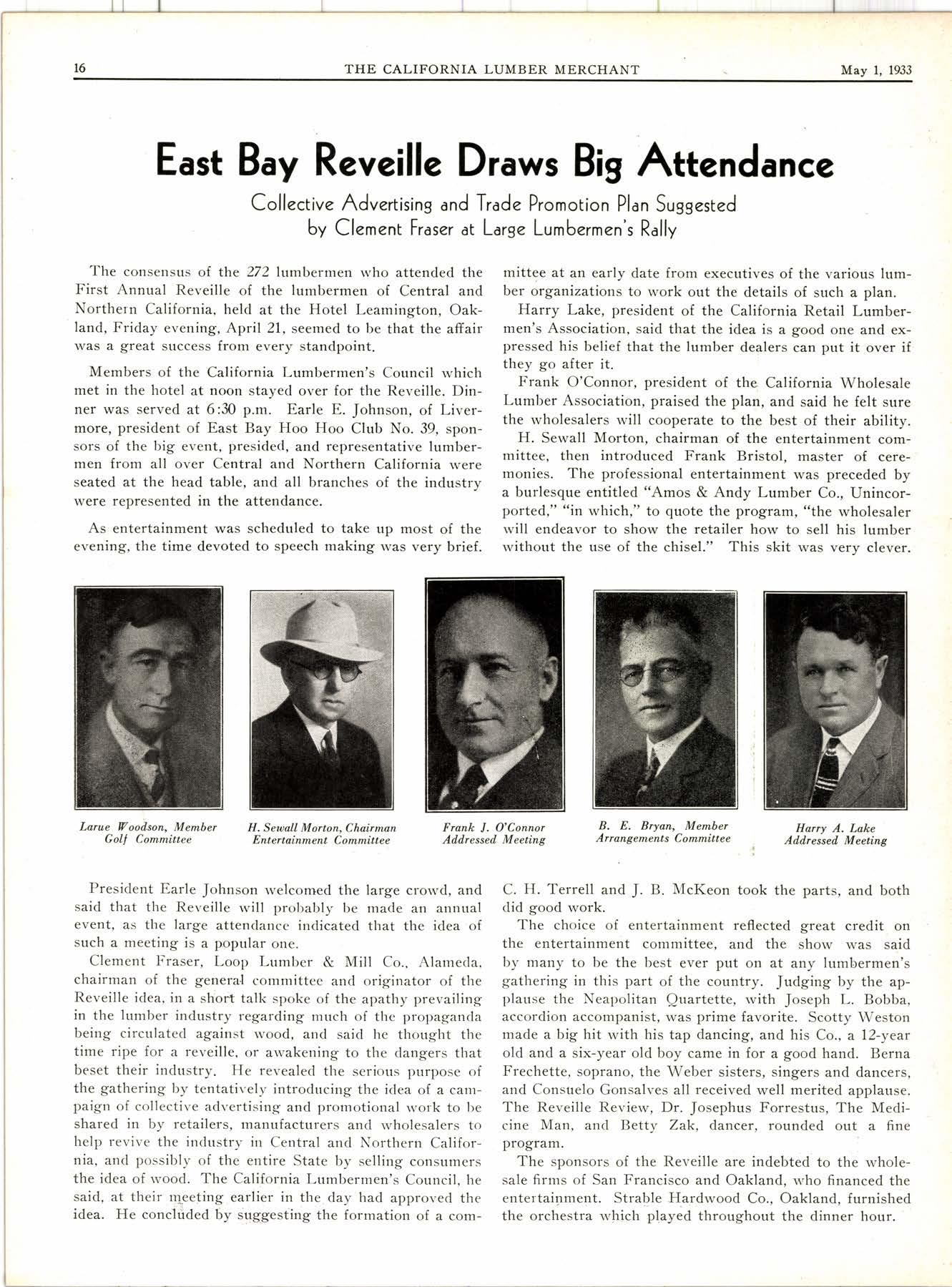
3 minute read
Emergency Forest Employment \(/ork Will Increase Future Forest Supplies
Washington, April 15.-The recent authorization by the U. S. Timber Conservation Board of the publication of the report of its Special Advisory Committee on the forest situation of the United States, coin'cides opp,ortunely with President Roosevelt's proposal to give emergency employment to 200,000 men in the forests. This employment is intended to be largely in the nature of improvement of the ultimate productive capacity of the forests through such measures as thinning out over-thi,ck stands of young trees, cleaning up forest debris and slash, removal of diseased trees, cutting of fire lanes, communication trails, etc.
It is significant, according to President Wilson Compton of American Forest Products Industries, Inc., that the report states that the present forest problem in the United States is not one of timber shortage, but of the proper protection and management of forested areas, including adjustment of produ'ction of forest products between and within the forest regions to secure best results from existing forest growing stock. The area now,covered with commercial forests and likely to remain available for that purpose, if given ample protection and management, is more than sufficient, according to the report, to meet any probable future demand.
"President Roosevelt's plan", says Dr. Compton, "is primarily an emergency employment help. But it is much more than that. If wisely planned with the expert help available from the Forest Service it will restore timber production in those regions in which the timber supplies are relatively the smallest and in which the future need of timber production evidently is the greatest."
The Present Forest Situation
In the detailed report on the forest situation in the United States, which was prepared by the United States Forest Service, the present forest area in the continental United States, omitting Alaska, is placed at 496,000,000 as1s5-abeut equal to the entire improved farm area of the nation-estimated to contain approximately 487 billion cubic feet of saw timber, cordw.ood, pulpwood and other commer'cial forest material. The estimated present current annual growth. of timber now of mer'chantable size is 7 billion cubic feet. In addition, there is an annual growth not now of merchantable size, of 3rl billion feet.
The total annual drain on the forests based on 1925'29 production amounts approximately to 16l/3 billion cubic feet, including 870 million feet destroyed by fire and 940 rnillion feet destroyed by insects, disease, drought and wind. To meet the commodity drain ol l4l billion cubic feet, it is estimated that there is a forest growing stock ol 487 billion cubic feet as against a requirement of 458 billion cubic feet.
These favorable statistics,. however, must be viewed in the light of unsatisfactory conditions, consisting of a lack of adequate fire protection, in the unbalanced cut as be- trveen different forest regions and within those regions; in the failure to apply the principle of selective logging both in individual trees and the .stands, to practice sustained yield, to provide seed trees and to take other precautions to assure natural restocking.
Distribution of Forest Areas and Supplies
On the assumption that the bulk of the forest improvement employment work will be in the eastern half of the United States (adjacent to centers of unemployment) it is noteworthy that the forest area in that region is overwhelmingly in private hands. In the New England states the national and state forests comprise only 296,000 acres, whereas farmers own 6,400,000 a,cres and others 19,577,W acres. In the middle Atlanti,c region the public forests cover 2,209,000 acres; farm woodlots 9,454,W and other ownership 15,476,W. In the Lake regions the figures are respectively 6,822,M, 12,245,0ffi and 36,828,000. In the. central region the corresponding figures are 772,A00,W, 32,158,000 and 31,319,000. In the Southeastern region the figures are 9,494,000, 57,86,06 and 124,379,W. On the other hand, in the Pacific Coast region the gdvernment holdings are 33,649,000 acres; farm lots 5,099,000, and other ownership 27,937 ,W. For the entire United States, government-owned forest land totals L04,62,000 acres; farm woodlots I24,678,W and other, mainly ,commercial, ownership accounts for 266,539,0@ acres.
In reference to the supply in the eastern region, which includes New England, middle Atlantic, Lake and central regions, the report pla'ces standing saw timber of merchantable size at about 155,0CX),0(}) board feet, which is less than l0 per cent of the total for the nation. The old growth stands of these four regions comprise less than 60,000,000; 000 board feet.
The fa'ct that there is still ,considerable old growth timber in these regions whose industries are dra;wing heavily on the distant timber supplies, indicates, according to the report, that the local supply is relatively inaccessible or of poor quality. It is a justifiable inference that emergency employment could be most advantageously used in this part of the country; for the report says that in the far western zone, the surplus of virgin mature timber is so great that the current cut marr be greatly accelerated.
According to American Forest Products Industries intelligent, even if temporary, forest improvement work will contribute powerfully to that balan'ced condition of the forests which, according to the committee's report, will, within 70 years, so increase growth as to allow an annual commercial drain of forest products amounting to about 5 billion cubic feet more than at present. With greater improvement it is estimated that the growing stock can be increased during the next 7A years to permit of an annual drain of 30 billion cubic feet.










